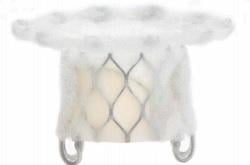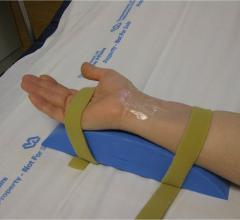
Guerbet announced a worldwide launch of FlowSens, a contrast agent injection solution used in X-ray medical examinations. FlowSens received CE marking in the first quarter of 2014. It will initially be marketed in Europe (first in Belgium, France, Germany and Switzerland), then gradually in other regions of the world.
Marty Greenfield lives with crushing pain every day due to angina. He has suffered a heart attack, and a coronary bypass procedure and angioplasty have provided little relief. His doctor referred him to University of California, Los Angeles to be considered for a heart transplant.
After a heart attack, there is often permanent damage to a portion of the heart. This happens, in part, because cardiac muscle cells are terminally differentiated and cannot proliferate after blood flow is blocked off to the heart. This partial healing can be attributed to heart disease being one of the leading causes of death. What if the cells could be stimulated to divide and the heart could be induced to repair itself? This was the question posed by George Washington University researcher Scott Shapiro, M.D., Ph.D., and his co-authors. They found cardiac regeneration may be a possibility with gene therapy.
Providing exceptional cardiovascular care for patients to achieve the best possible outcomes is the number one goal for ...
ImaCor Inc., the developer of hemodynamic transesophageal echocardiography (hTEE) technology, announced four academic hTEE presentations. Physicians are publicly recognizing hTEE as a tool for managing complex ICU patients.
GE Healthcare is dedicated to helping healthcare organizations build a roadmap for a comprehensive radiation dose ...
Without administering a simple blood test in the first few days after surgery, 85 percent of the heart attacks or injuries patients suffer could be missed, according to a study in the March issue of Anesthesiology. Globally, more than 8 million adults have heart attacks or injuries after surgery every year, and 10 percent of those patients die within 30 days.
Cardiac positron emission tomography (PET) is growing in popularity among cardiologists because it provides the ability ...
A big trend in healthcare IT at HIMSS 2014 was the creation of enterprise-wide image access systems. With the ...
The American College of Cardiology (ACC) and the American Heart Assn. (AHA) have released a mobile and Web-based app for health care professionals to use with their patients in determining 10-year and lifetime risks for developing atherosclerotic cardiovascular disease (ASCVD), the major cause of heart attack and ischemic stroke.

Deep vein thrombosis (DVT) often brings with it the risk of post-thrombotic syndrome (PTS), an under-recognized but serious complication that often causes long-term disability for patients. During March's DVT Awareness Month, the Society of Interventional Radiology wants to help patients and family members better understand the long-term risks of DVT.
When performing radiofrequency (RF) ablation to treat cardiac arrhythmia, medical professionals must balance the safety ...
The Spectranetics Corp. announced that the Excite ISR trial achieved the statistical endpoints of the adjunct analysis. The trial evaluates laser atherectomy plus percutaneous transluminal angioplasty (PTA) compared with PTA alone for the treatment of in-stent restenosis (ISR) in patients suffering from peripheral artery disease (PAD).
Interventional radiologists have devised a way to access a woman's fibroids by flipping her wrist and treating via an arm not groin artery. It can be used to nonsurgically shrink noncancerous growths in the muscular wall of the uterus. Researchers found this to be less painful and traumatic for women, allowing them to immediately sit up and move after uterine fibroid embolization (UFE)—with no overnight stay. This is according to a March article in the Journal of Vascular and Interventional Radiology.

If the exhibit floor of the 99th Scientific Assembly and Annual Meeting of the Radiological Society of North America (RSNA) had one standout modality this year, it was, without question, the advances with premium computed tomography (CT). Technological and clinical advances in magnetic resonance (MR) and molecular imaging were less impressive but were no less significant. Naturally, these developments in every advanced imaging modality are turning eyes to advanced visualization (AV) and clinical applications. AV is not just a core step in the interpretation workflow of each of these modalities. More than that, it is the set of solutions that will allow the realization of the promises of these imaging advances — the ones that will “make sense” of these upgraded imaging capabilities by using innovative ways to interrogate their improved image depth and visualize their enhanced image quality.
Change Healthcare Cardiology Hemodynamics is an integrated hemodynamic monitoring system for monitoring vital signs and ...
Memorial Hospital in Carbondale, Ill., has chosen Quail Digital’s healthcare wireless headset system. It will be used in catheterization and electrophysiology labs where all coronary and peripheral vascular interventions, device implants and electrophysiology procedures are performed.
MedStar Heart Institute of Washington, D.C., and Infraredx Inc. enrolled the first participant in the Lipid-Rich Plaque (LRP) Study. The LRP Study is a prospective, multi-center study aimed at identifying a correlation between LRPs and the occurrence of a cardiac event within two years.

Edwards Lifesciences Corp. announced the successful completion of the first three human implants of its Fortis mitral transcatheter heart valve. The Heart Team at St. Thomas’ Hospital in London performed them in February and March.

 March 11, 2014
March 11, 2014












